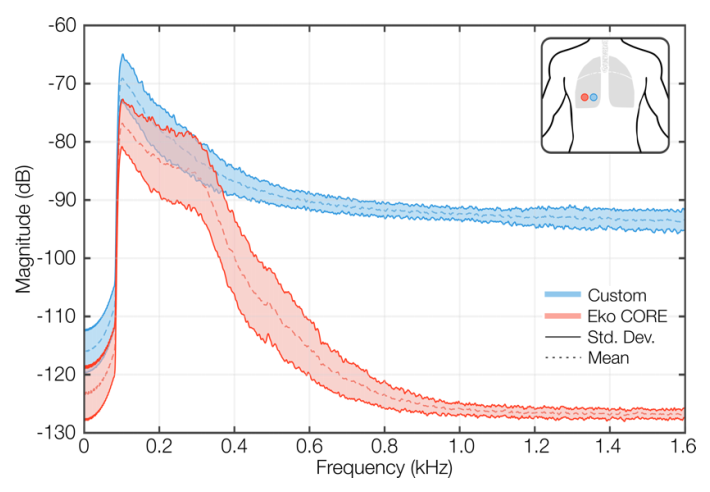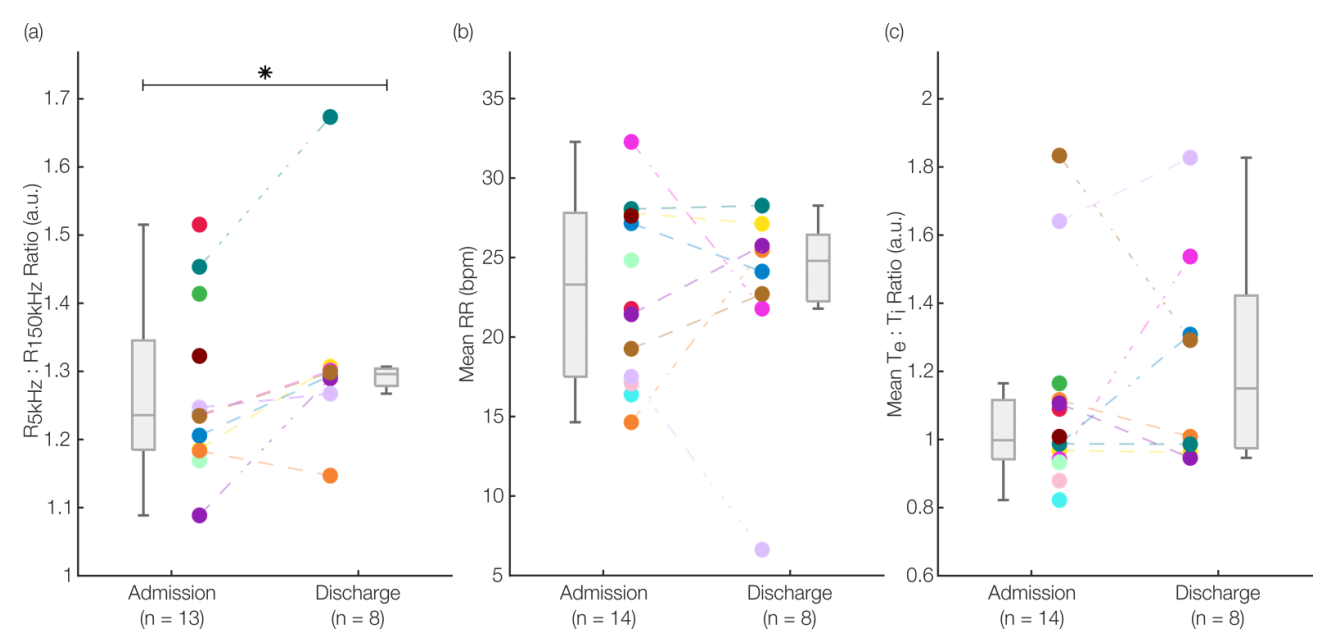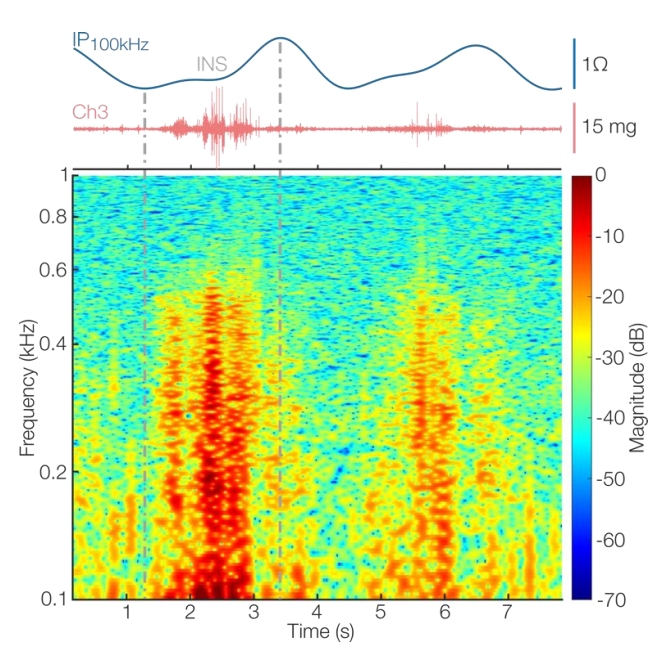A Wearable Multimodal Sensing System for Tracking Changes in Pulmonary Fluid Status, Lung Sounds, and Respiratory Markers
Abstract
:1. Introduction
2. Materials and Methods
2.1. System Adaptation for Respiratory Sensing
2.1.1. Hardware Modifications
2.1.2. Packaging Design
2.1.3. Acoustic Design
2.1.4. Sensor Placement
2.1.5. System Operational Modes
2.2. In-Lab Validation of System
2.3. Proof-of-Concept Clinical Study
2.4. Signal Visualization and Interpretation
2.5. Signal Processing
2.5.1. Continuous Data
2.5.2. Spectroscopy Data
2.6. Statistical Analysis
3. Results and Discussion
3.1. Acoustic Validation against Eko CORE
3.2. Results from Proof-of-Concept Clinical Recordings
3.2.1. Detecting Changes in Pulmonary Fluid Status
3.2.2. Extraction of Respiratory Health Markers
3.2.3. Cheyne–Stokes Respiration (CSR)
3.2.4. Inspiratory Crackles
4. Limitations and Future Work
4.1. Study Limitations
4.2. Hardware Improvements
4.3. Lung Sounds Quality, Analysis, and Multimodal Fusion
5. Conclusions
Supplementary Materials
Author Contributions
Funding
Institutional Review Board Statement
Informed Consent Statement
Data Availability Statement
Acknowledgments
Conflicts of Interest
References
- Virani, S.S.; Alonso, A.; Benjamin, E.J.; Bittencourt, M.S.; Callaway, C.W.; Carson, A.P.; Chamberlain, A.M.; Chang, A.R.; Cheng, S.; Delling, F.N.; et al. Heart disease and stroke statistics-2020 update: A report from the american heart association. Circulation 2020, 141, E139–E596. [Google Scholar] [CrossRef]
- Inamdar, A.A.; Inamdar, A.C. Inamdar Heart failure: Diagnosis, management and utilization. J. Clin. Med. 2016, 5, 62. [Google Scholar] [CrossRef] [PubMed]
- Solomon, S.D.; Dobson, J.; Pocock, S.; Skali, H.; Mcmurray, J.; Granger, C.B.; Yusuf, S.; Swedberg, K.; Young, J.B.; Michelson, E.L.; et al. Influence of nonfatal hospitalization for heart failure on subsequent mortality in patients with chronic heart failure. Circulation 2007, 116, 1482–1487. [Google Scholar] [CrossRef] [PubMed] [Green Version]
- Ambrosy, A.P.; Pang, P.S.; Khan, S.; Konstam, M.A.; Fonarow, G.C.; Traver, B.; Maggioni, A.P.; Cook, T.; Swedberg, K.; Burnett, J.C.; et al. Clinical course and predictive value of congestion during hospitalization in patients admitted for worsening signs and symptoms of heart failure with reduced ejection fraction: Findings from the EVEREST trial. Eur. Heart J. 2013, 34, 835–843. [Google Scholar] [CrossRef] [PubMed] [Green Version]
- Arts, L.; Lim, E.H.T.; van de Ven, P.M.; Heunks, L.; Tuinman, P.R. The diagnostic accuracy of lung auscultation in adult patients with acute pulmonary pathologies: A meta-analysis. Sci. Rep. 2020, 10, 1–11. [Google Scholar] [CrossRef] [PubMed]
- Gheorghiade, M.; Follath, F.; Ponikowski, P.; Barsuk, J.H.; Blair, J.E.; Cleland, J.G.; Dickstein, K.; Drazner, M.H.; Fonarow, G.C.; Jaarsma, T.; et al. Assessing and grading congestion in acute heart failure: A scientific statement from the acute heart failure committee of the heart failure association of the European Society of Cardiology and endorsed by the European Society of Intensive Care Medicine. Eur. J. Heart Fail. 2010, 12, 423–433. [Google Scholar] [CrossRef] [PubMed]
- Askanazi, J.; Silverberg, P.A.; Foster, R.J.; Hyman, A.I.; Milic-Emili, J.M.J. Kinney Effects of respiratory apparatus on breathing pattern. J. Appl. Physiol. 1980, 48, 577–580. [Google Scholar] [CrossRef] [PubMed]
- Zink, M.D.; König, F.; Weyer, S.; Willmes, K.; Leonhardt, S.; Marx, N.; Napp, A. Segmental Bioelectrical Impedance Spectroscopy to Monitor Fluid Status in Heart Failure. Sci. Rep. 2020, 10, 3577. [Google Scholar] [CrossRef]
- Accardi, J.A.; Matsubara, B.S.; Gaw, R.L.; Daleiden-Burns, A.T.J. Heywood Clinical utility of fluid volume assessment in heart failure patients using bioimpedance spectroscopy. Front. Cardiovasc. Med. 2021, 8, 636718. [Google Scholar] [CrossRef]
- Bohadana, A.; Izbicki, G.; Kraman, S.S. Fundamentals of Lung Auscultation. N. Engl. J. Med. 2014, 370, 744–751. [Google Scholar] [CrossRef] [Green Version]
- Rao, A.; Huynh, E.; Royston, T.J.; Kornblith, A.; Roy, S. Acoustic Methods for Pulmonary Diagnosis. IEEE Rev. Biomed. Eng. 2019, 12, 221–239. [Google Scholar] [CrossRef] [Green Version]
- Mukherjee, H.; Sreerama, P.; Dhar, A.; Obaidullah, S.M.; Roy, K.; Mahmud, M.; Santosh, K. Automatic Lung Health Screening Using Respiratory Sounds. J. Med. Syst. 2021, 45, 19. [Google Scholar] [CrossRef]
- Charleston-Villalobos, S.; Martinez-Hernandez, G.; Gonzalez-Camarena, R.; Chi-Lem, G.; Carrillo, J.G.; Aljama-Corrales, T. Assessment of multichannel lung sounds parameterization for two-class classification in interstitial lung disease patients. Comput. Biol. Med. 2011, 41, 473–482. [Google Scholar] [CrossRef]
- Flietstra, B.; Markuzon, N.; Vyshedskiy, A.; Murphy, R. Automated Analysis of Crackles in Patients with Interstitial Pulmonary Fibrosis. Pulm. Med. 2010, 2011, 1–7. [Google Scholar] [CrossRef]
- Seppä, V.-P.; Viik, J.; Hyttinen, J. Assessment of pulmonary flow using impedance pneumography. IEEE Trans. Biomed. Eng. 2011, 57, 2277–2285. [Google Scholar] [CrossRef]
- Berkebile, J.A.; Mabrouk, S.; Ganti, V.; Srivatsa, A.; Sanchez-Perez, J.; Inan, O. Towards Estimation of Tidal Volume and Respiratory Timings via Wearable-Patch-Based Impedance Pneumography in Ambulatory Settings. IEEE Trans. Biomed. Eng. 2021, 1. [Google Scholar] [CrossRef]
- Seppä, V.P.; Pelkonen, A.S.; Kotaniemi-Syrjänen, A.; Viik, J.; Mäkelä, M.J.P.L. Malmberg Tidal flow variability measured by impedance pneumography relates to childhood asthma risk. Eur. Respir. J. 2016, 47, 1687–1696. [Google Scholar] [CrossRef]
- Klum, M.; Urban, M.; Tigges, T.; Pielmus, A.-G.; Feldheiser, A.; Schmitt, T.; Orglmeister, R. Wearable cardiorespiratory monitoring employing a multimodal digital patch stethoscope: Estimation of ECG, PEP, LVET and respiration using a 55 mm single-lead ECG and phonocardiogram. Sensors 2020, 20, 2033. [Google Scholar] [CrossRef] [Green Version]
- Frerichs, I.; Vogt, B.; Wacker, J.; Paradiso, R.; Braun, F.; Rapin, M.; Caldani, L.; Chételat, O.; Weiler, N. Multimodal remote chest monitoring system with wearable sensors: A validation study in healthy subjects. Physiol. Meas. 2019, 41, 015006. [Google Scholar] [CrossRef]
- Beck, C.; Georgiou, J. Wearable, multimodal, vitals acquisition unit for intelligent field triage. Healthc. Technol. Lett. 2016, 3, 189–196. [Google Scholar] [CrossRef] [Green Version]
- Teague, C.N.; Heller, J.A.; Nevius, B.N.; Carek, A.M.; Mabrouk, S.; Garcia-Vicente, F.; Inan, O.T.; Etemadi, M. A Wearable, Multimodal Sensing System to Monitor Knee Joint Health. IEEE Sens. J. 2020, 20, 10323–10334. [Google Scholar] [CrossRef]
- Medical Electrical Equipment—Part 1-11: General Requirements for Basic Safety and Essential Performance—Collateral Standard: Requirements for Medical Electrical Equipment and Medical Electrical Systems Used in the Home Healthcare Environment. 2015. Available online: https://www.iso.org/standard/65529.html (accessed on 30 December 2021).
- Mabrouk, S.; Hersek, S.; Jeong, H.K.; Whittingslow, D.; Ganti, V.G.; Wolkoff, P.; Inan, O.T. Robust Longitudinal Ankle Edema Assessment Using Wearable Bioimpedance Spectroscopy. IEEE Trans. Biomed. Eng. 2020, 67, 1019–1029. [Google Scholar] [CrossRef]
- Teague, C.N.; Hersek, S.; Toreyin, H.; Millard-Stafford, M.L.; Jones, M.L.; Kogler, G.F.; Sawka, M.N.; Inan, O.T. Novel Methods for Sensing Acoustical Emissions from the Knee for Wearable Joint Health Assessment. IEEE Trans. Biomed. Eng. 2016, 63, 1581–1590. [Google Scholar] [CrossRef]
- Yilmaz, G.; Rapin, M.; Pessoa, D.; Rocha, B.M.; De Sousa, A.M.; Rusconi, R.; Carvalho, P.; Wacker, J.; Paiva, R.P.; Chételat, O. A Wearable Stethoscope for Long-Term Ambulatory Respiratory Health Monitoring. Sensors 2020, 20, 5124. [Google Scholar] [CrossRef]
- Nevius, B. The Mechanical Design and Optimization of a Wearable Multimodal Health Sensing System. Georgia Institute of Technology. 2020. Available online: https://smartech.gatech.edu/handle/1853/64186?show=full (accessed on 15 October 2021).
- Toda, M.; Thompson, M. Contact-Type Vibration Sensors Using Curved Clamped PVDF Film. IEEE Sens. J. 2006, 6, 1170–1177. [Google Scholar] [CrossRef]
- Ozmen, G.C.; Safaei, M.; Lan, L.; Inan, O.T.A. Novel Accelerometer Mounting Method for Sensing Performance Improvement in Acoustic Measurements from the Knee. J. Vib. Acoust. 2021, 143, 031006. [Google Scholar] [CrossRef] [PubMed]
- Kahya, Y.P. Breath Sound Recording. In Breath Sounds; Priftis, K.N., Hadjileontiadis, L.J., Everard, M.L., Eds.; Springer International Publishing: Cham, Switzerland, 2018; pp. 119–137. [Google Scholar] [CrossRef]
- Jung, H.; Mabrouk, S.; Inan, O.T. Impedance Pneumography: Assessment of Dual-Frequency Calibration Approaches. In Proceedings of the 2021 IEEE 17th International Conference on Wearable and Implantable Body Sensor Networks (BSN), Athens, Greece, 27–30 July 2021; pp. 1–4. [Google Scholar] [CrossRef]
- Beckmann, L.; van Riesen, D.; Leonhardt, S. Optimal electrode placement and frequency range selection for the detection of lung water using Bioimpedance Spectroscopy. In Proceedings of the 2007 29th Annual International Conference of the IEEE Engineering in Medicine and Biology Society, Lyon, France, 23–26 August 2007; pp. 2685–2688. [Google Scholar] [CrossRef]
- Rossi, M.; Sovijärvi, A.; Piirilä, P.; Vannuccini, L.; Dalmasso, F.; Vanderschoot, J. Environmental and subject conditions and breathing manoeuvres for respiratory sound recordings. Eur. Respir. Rev. 2000, 10, 611–615. [Google Scholar]
- Weyer, S.; Zink, M.D.; Wartzek, T.; Leicht, L.; Mischke, K.; Vollmer, T.; Leonhardt, S. Bioelectrical impedance spectroscopy as a fluid management system in heart failure. Physiol. Meas. 2014, 35, 917–930. [Google Scholar] [CrossRef] [PubMed]
- Dovancescu, S.; Saporito, S.; Herold, I.H.F.; Korsten, H.H.M.; Aarts, R.M.; Mischi, M. Monitoring thoracic fluid content using bioelectrical impedance spectroscopy and Cole modeling. J. Electr. Bioimpedance 2017, 8, 107–115. [Google Scholar] [CrossRef] [Green Version]
- Graceffo, S.; Husain, A.; Ahmed, S.; McCollum, E.D. Elhilali Validation of Auscultation Technologies using Objective and Clinical Comparisons. In Proceedings of the 2020 42nd Annual International Conference of the IEEE Engineering in Medicine & Biology Society (EMBC), Montreal, QC, Canada, 20–24 July 2020; pp. 992–997. [Google Scholar] [CrossRef]
- Rocha, B.M.; Pessoa, D.; Marques, A.; Carvalho, P.; Paiva, R.P. Automatic Classification of Adventitious Respiratory Sounds: A (Un)Solved Problem? Sensors 2020, 21, 57. [Google Scholar] [CrossRef]
- Charlton, P.H.; Bonnici, T.; Tarassenko, L.; Clifton, D.A.; Beale, R.; Watkinson, P.J.; Alastruey, J. An impedance pneumography signal quality index: Design, assessment and application to respiratory rate monitoring. Biomed. Signal Process. Control. 2021, 65, 102339. [Google Scholar] [CrossRef]
- Gazi, A.H.; Wittbrodt, M.T.; Harrison, A.B.; Sundararaj, S.; Gurel, N.Z.; Nye, J.A.; Shah, A.J.; Vaccarino, V.; Bremner, J.D.; Inan, O.T. Robust Estimation of Respiratory Variability Uncovers Correlates of Limbic Brain Activity and Transcutaneous Cervical Vagus Nerve Stimulation in the Context of Traumatic Stress. IEEE Trans. Biomed. Eng. 2021, 69, 2. [Google Scholar] [CrossRef]
- Marcy, T.W.; Marini, J.J. Inverse Ratio Ventilation in ARDS. Chest 1991, 100, 494–504. [Google Scholar] [CrossRef]
- Zamoscik, V.E.; Schmidt, S.N.L.; Gerchen, M.F.; Samsouris, C.; Timm, C.; Kuehner, C.; Kirsch, P. Respiration pattern variability and related default mode network connectivity are altered in remitted depression. Psychol. Med. 2018, 48, 2364–2374. [Google Scholar] [CrossRef] [Green Version]
- Seppä, V.-P.; Viik, J.; Naveed, A.; Väisänen, J.; Hyttinen, J. Signal waveform agreement between spirometer and impedance pneumography of six chest band electrode configurations. In Proceedings of the World Congress on Medical Physics and Biomedical Engineering, Munich, Germany, 7–12 September 2009; Dössel, O., Schlegel, W.C., Eds.; Springer: Berlin/Heidelberg, Germany, 2009; Volume 25, pp. 689–692. [Google Scholar] [CrossRef]
- Młyńczak, M.; Niewiadomski, W.; Żyliński, M.; Cybulski, G. Assessment of calibration methods on impedance pneumography accuracy. Biomed. Eng. Biomed. Tech. 2016, 61, 587–593. [Google Scholar] [CrossRef]
- Grimnes, S.; Martinsen, O. Bioimpedance and Bioelectricity Basics. 2011. Available online: https://books.google.com/books?hl=en&lr=&id=v3EuUjoqwkkC&oi=fnd&pg=PP1&dq=Bioimpedance+and+bioelectricity+basics&ots=OZOlX7plVh&sig=0gwPoJIWNgOByV6X4l6cswHAk1M (accessed on 1 November 2021).
- Callaghan, M.F.; Lund, T.; Roitt, I.M.; Bayford, H.R. Positive phase error from parallel conductance in tetrapolar bio-impedance measurements and its compensation. J. Electr. Bioimpedance 2010, 1, 71–79. [Google Scholar] [CrossRef] [Green Version]
- Grimnes, S.; Martinsen, G.Ø. Sources of error in tetrapolar impedance measurements on biomaterials and other ionic conductors. J. Phys. Appl. Phys. 2006, 40, 9–14. [Google Scholar] [CrossRef]
- Orschulik, J.; Hochhausen, N.; Czaplik, M.; Santos, S.A.; Leonhardt, S. Walter Impact of lung pathologies on bioimpedance spectroscopy measurements-an experimental study. Int. J. Bioelectromagn. 2020, 22, 1–19. [Google Scholar]
- Sakaguchi, T.; Yasumura, K.; Nishida, H.; Inoue, H.; Furukawa, T.; Shinouchi, K.; Miura, H.; Miyazaki, K.; Hamano, G.; Koide, M.; et al. Quantitative assessment of fluid accumulation using bioelectrical impedance analysis in patients with acute decompensated heart failure. Circ. J. 2015, 79, 2616–2622. [Google Scholar] [CrossRef] [Green Version]
- Rosner, B. Fundamentals of Biostatistics, 7th ed.; Brooks/Cole, Cengage Learning: Boston, MA, USA, 2011. [Google Scholar]
- Oliveira, A.; Marques, A. Respiratory sounds in healthy people: A systematic review. Respir. Med. 2014, 108, 550–570. [Google Scholar] [CrossRef] [Green Version]
- Mclane, I.M.; Emmanouilidou, D.; West, J.; Elhilali, M. Design and Comparative Performance of a Robust Lung Auscultation System for Noisy Clinical Settings. IEEE J. Biomed. Health Inform. 2021, 25, 7. [Google Scholar] [CrossRef]
- Andrès, E.; Gass, R.; Charloux, A.; Brandt, C.; Hentzler, A. Respiratory sound analysis in the era of evidence-based medicine and the world of medicine 2.0. J. Med. Life 2018, 11, 89–106. [Google Scholar]
- Kanai, H.; Sakamoto, K.; Haeno, M. Electrical measurement of fluid distribution in human legs: Estimation of extra- and intra-cellular fluid volume. J. Microw. Power 1983, 18, 233–243. [Google Scholar] [CrossRef]
- Rolfe, S. The importance of respiratory rate monitoring. Br. J. Nurs. 2019, 28, 504–508. [Google Scholar] [CrossRef]
- Goetze, S.; Zhang, Y.; An, Q.; Averina, V.; Lambiase, P.; Schilling, R.; Trappe, H.-J.; Winter, S.; Wold, N.; Manola, L.; et al. Ambulatory respiratory rate trends identify patients at higher risk of worsening heart failure in implantable cardioverter defibrillator and biventricular device recipients: A novel ambulatory parameter to optimize heart failure management. J. Interv. Card. Electrophysiol. 2015, 43, 21–29. [Google Scholar] [CrossRef] [Green Version]
- Brack, T.; Randerath, W.; Bloch, K.E. Cheyne-Stokes Respiration in Patients with Heart Failure: Prevalence, Causes, Consequences and Treatments. Respiration 2012, 83, 165–176. [Google Scholar] [CrossRef] [Green Version]
- Brack, T.; Thüer, I.; Clarenbach, C.F.; Senn, O.; Noll, G.; Russi, E.W.; Bloch, K.E. Daytime Cheyne-Stokes Respiration in Ambulatory Patients with Severe Congestive Heart Failure Is Associated with Increased Mortality. Chest 2007, 132, 1463–1471. [Google Scholar] [CrossRef]
- Kraman, S.S. Sound Transmission Through the Human Body. In Breath Sounds; Priftis, K.N., Hadjileontiadis, L.J., Everard, M.L., Eds.; Springer International Publishing: Cham, Switzerland, 2018; pp. 105–118. [Google Scholar] [CrossRef]
- Kraman, S.S. The relationship between airflow and lung sound amplitude in normal subjects. Chest 1984, 86, 225–229. [Google Scholar] [CrossRef]
- Karnath, B.; Thornton, W. Auscultation of the heart. Hosp. Physician 2002, 38, 39–45. [Google Scholar]
- Dharmarajan, K.; Hsieh, A.F.; Lin, Z.; Bueno, H.; Ross, J.; Horwitz, L.; Barreto-Filho, J.A.; Kim, N.; Bernheim, S.M.; Suter, L.G.; et al. Diagnoses and timing of 30-Day readmissions after hospitalization for heart failure, acute myocardial infarction, or pneumonia. JAMA J. Am. Med. Assoc. 2013, 309, 355–363. [Google Scholar] [CrossRef] [PubMed]







| Parameter | Value |
|---|---|
| Average Power Consumption | |
| Sleep | 0.5 mA |
| Continuous Mode | 27.6 mA |
| Spectroscopy Mode | 16.8 mA |
| Battery Life (with 500 mAh Battery) | |
| Sleep | 41.6 days |
| Continuous Mode | 18 h |
| Spectroscopy Mode | 30 h |
| Number of Measured Frequencies | |
| Continuous Mode | 4 |
| Spectroscopy Mode | 32 |
| Sampling Rate 1 | |
| Continuous Mode | 16 Hz |
| Spectroscopy Mode | 0.5 Hz |
| Frequency Range | 5–150 kHz |
| Excitation Voltage | 450 mVpeak |
| Mean Resistance (R) Error | 0.50 Ω |
| Mean Reactance (X) Error | 0.44 Ω |
| Noise Floor 2 | 7.8 mΩ |
| Parameter | Patient Data (n = 14) |
|---|---|
| Age (years), mean (SD) | 50.2 (11.5) |
| Sex, n (%) | |
| Male | 9 (64) |
| Female | 5 (36) |
| Height (cm), mean (SD) | 174.1 (10.1) |
| Weight (kg), mean (SD) | 124.1 (55.3) |
| BMI (kg/m2), mean (SD) | 41.2 (19.1) |
| Race, n (%) | |
| Black | 13 (93) |
| White | 1 (7) |
| Parameter | Custom Mean (SD) | Eko CORE Mean (SD) |
|---|---|---|
| Fmax (Hz) | 118.21 (3.50) | 123.19 (9.91) |
| F50 (Hz) | 212.67 (60.11) | 150.14 (14.79) |
| F95 (Hz) | 946.84 (170.36) | 272.94 (20.09) |
Publisher’s Note: MDPI stays neutral with regard to jurisdictional claims in published maps and institutional affiliations. |
© 2022 by the authors. Licensee MDPI, Basel, Switzerland. This article is an open access article distributed under the terms and conditions of the Creative Commons Attribution (CC BY) license (https://creativecommons.org/licenses/by/4.0/).
Share and Cite
Sanchez-Perez, J.A.; Berkebile, J.A.; Nevius, B.N.; Ozmen, G.C.; Nichols, C.J.; Ganti, V.G.; Mabrouk, S.A.; Clifford, G.D.; Kamaleswaran, R.; Wright, D.W.; et al. A Wearable Multimodal Sensing System for Tracking Changes in Pulmonary Fluid Status, Lung Sounds, and Respiratory Markers. Sensors 2022, 22, 1130. https://doi.org/10.3390/s22031130
Sanchez-Perez JA, Berkebile JA, Nevius BN, Ozmen GC, Nichols CJ, Ganti VG, Mabrouk SA, Clifford GD, Kamaleswaran R, Wright DW, et al. A Wearable Multimodal Sensing System for Tracking Changes in Pulmonary Fluid Status, Lung Sounds, and Respiratory Markers. Sensors. 2022; 22(3):1130. https://doi.org/10.3390/s22031130
Chicago/Turabian StyleSanchez-Perez, Jesus Antonio, John A. Berkebile, Brandi N. Nevius, Goktug C. Ozmen, Christopher J. Nichols, Venu G. Ganti, Samer A. Mabrouk, Gari D. Clifford, Rishikesan Kamaleswaran, David W. Wright, and et al. 2022. "A Wearable Multimodal Sensing System for Tracking Changes in Pulmonary Fluid Status, Lung Sounds, and Respiratory Markers" Sensors 22, no. 3: 1130. https://doi.org/10.3390/s22031130
APA StyleSanchez-Perez, J. A., Berkebile, J. A., Nevius, B. N., Ozmen, G. C., Nichols, C. J., Ganti, V. G., Mabrouk, S. A., Clifford, G. D., Kamaleswaran, R., Wright, D. W., & Inan, O. T. (2022). A Wearable Multimodal Sensing System for Tracking Changes in Pulmonary Fluid Status, Lung Sounds, and Respiratory Markers. Sensors, 22(3), 1130. https://doi.org/10.3390/s22031130






